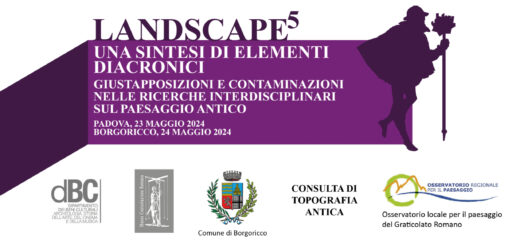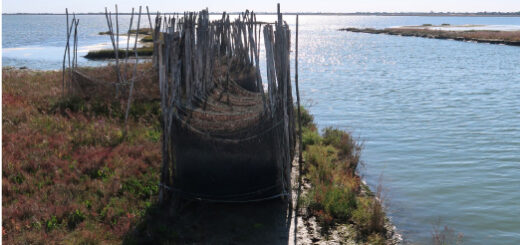LANDSCAPE6 – UNA SINTESI DI ELEMENTI DIACRONICI – EMPTYSCAPES, PAESAGGI MARGINALI E PAESAGGI RILEVATI – SIENA, 14-16 APRILE 2025 – deadline 15 dicembre 2024
Papers will be 20 minutes in length. Abstracts and affiliation details, no longer than 300 words, should be submitted online at this link. Deadline: December 15th 2024.
KEYNOTE SPEAKER: Prof. ROBERT WITCHER (Durham University), Prof. HECTOR A. ORENGO (ICREA, Catalan Institute of Classical Archaeology).
SCIENTIFIC COMMITTEE: Giuseppe Ceraudo, Stefano Campana, Beatrice Fochetti, Davide Gangale Risoleo, Enrico Giorgi, Stephen Kay, Paolo Liverani, Maria Luisa Marchi, Giovanna Pizziolo, Stefania Quilici Gigli, Marcello Spanu, Jacopo Turchetto
SESSIONS
1. FROM CITY TO TERRITORY: ANALYSIS, EXPLOITATION, AND MANAGEMENT
The first session focuses on the complex relationships between cities and suburban landscapes by seeking to identify the systems of reciprocal influence, interconnection, and interaction between them. The session includes those themes related to the understanding of various categories of territories, the analysis of territorial social and political aspects, and the exploitation and management of natural resources and economic systems, by prioritising research on those landscapes that fit within the definition of ‘marginal’. In this regard, mountains and forests, as well as lagoons and coastal areas, may have had different physiognomies and meanings than those we apply today. This raises questions on how to examine and interpret the complex relationships between cities and suburban landscapes by exploring dynamics of interaction and mutual influence.
2. COMMUNICATION ROUTES: SECONDARY ROADS, MINOR SETTLEMENTS, AND MARGINAL LANDSCAPES
The second session explores the relationship between secondary roads and ‘marginal’ landscapes. Key attention will be paid to ‘minor’ thoroughfares owing to their important role in connecting territories and creating links between settlements and peripheral landscapes. In this session, the role of transhumance routes, short- and medium-distance trade, and maritime and lagoon routes will be explored by highlighting how these communication networks influenced the physiognomy and development of ‘marginal’ landscapes. Analysing the landscape in these terms fosters the creation of a more articulated and structured picture of the vital role of secondary communication routes.
3. UNVEILING THE INVISIBLE: APPROACHES AND METHODS FOR THE STUDY OF COMPLEX LANDSCAPES
The third session focuses on the identification and application of new approaches, methods, and instruments, including those borrowed from other disciplines, which are suitable for the analysis of highly-complex landscapes. New tools, including A.I. and remote sensing, assume great importance in the study of ancient landscape contexts, both terrestrial, and underwater. For instance, geophysical prospection represents an increasingly widespread tool in archaeological investigations. Such is the increasing popularity of these techniques that they are no longer considered auxiliary or secondary in archaeological research but rather have become essential for the identification and understanding of challenging landscapes.
4. WHEN HUMAN ACTIONS MAKE A TERRITORY INACCESSIBLE: FROM DATA COLLECTION TO CULTURAL DIPLOMACY IN WAR ZONES
The fourth session explores how archaeological heritage faces significant threats from armed conflict and terrorism, leading to the destruction and looting of important cultural sites (Palmyra and Aleppo) which span various historical periods (from the Prehistoric, Byzantine, Roman, to the Islamic periods). The violence within these conflicts is not, of course, limited to the destruction of heritage sites, but also to looting and the increasing illicit trafficking of antiquities. With traditional protections failing, documentation and public engagement have become vital for preserving knowledge of these sites. This session will focus on global strategies for documenting and monitoring archaeological objects and landscapes in conflict zones, including management and reconstruction methods. Additionally, it will explore the role of archaeology in international relations and the concept of cultural diplomacy to promote joint efforts in heritage preservation.
5. EMPTYSCAPES, MARGINAL LANDSCAPES, AND REVEALED LANDSCAPES
The fifth session investigates the transformations of landscapes in marginal contexts in order to compare these dynamics with those related to other types of territories. The session focuses on theoretical and methodological aspects by referring to the interpretation of spatial distributions and to various meanings applied to settlement hierarchies and infrastructural patterns. The discussion deepens in previous studies and understands the highly significant impact of supposed gaps by bringing out the difference in content between ‘empty scapes’ and ‘revealed landscapes’.
Gli interventi avranno una durata di 20 minuti. La lunghezza massima degli abstract è di 300 parole. L’abstract va inviato attraverso il form online disponibile a questo link entro il 15 Dicembre 2024.
KEYNOTE SPEAKER: Prof. ROBERT WITCHER (Durham University), Prof. HECTOR A. ORENGO (ICREA, Catalan Institute of Classical Archaeology)COMITATO SCIENTIFICO: Giuseppe Ceraudo, Stefano Campana, Beatrice Fochetti, Davide Gangale Risoleo, Enrico Giorgi, Stephen Kay, Paolo Liverani, Maria Luisa Marchi, Giovanna Pizziolo, Stefania Quilici Gigli, Marcello Spanu, Jacopo Turchetto
COMITATO ORGANIZZATORE: Benedetta Baleani (La Sapienza University of Rome), Giuseppe Prospero Cirigliano (IMT Lucca), Alessia Mandorlo (University of Salento), Elena Pomar (The British School at Rome/University of Pisa), Federico Ugolini (University of Siena)
SESSIONI
1. DALLA CITTÀ AL TERRITORIO: ANALISI, GESTIONE E SFRUTTAMENTOLa prima sessione intende porre l’attenzione sul complesso rapporto tra città e paesaggio extraurbano, cercando di individuare i meccanismi di reciproca influenza, interconnessione e interazione tra di loro. Le tematiche trattate sono quelle relative alla comprensione del territorio in tutte le sue forme, dall’analisi degli aspetti sociali e politici, allo sfruttamento e gestione delle risorse, fino alla ricomposizione dei sistemi economici. Particolare attenzione viene rivolta a quei paesaggi che possiamo considerare marginali, tenendo conto che ambienti montani e boschivi, aree lagunari e costiere, possono aver avuto fisionomia e significati diversi da quelli attuali. La sessione intende dunque affrontare la questione su come leggere e interpretare il rapporto complesso tra città e paesaggio extraurbano.
2. VIE DI COMUNICAZIONE: VIABILITÀ SECONDARIA, INSEDIAMENTI MINORI E PAESAGGI MARGINALILa seconda sessione si rivolge al rapporto tra viabilità secondaria e i paesaggi marginali. Particolare attenzione sarà riservata alle vie di comunicazione “minori”, per l’importante ruolo svolto nella gestione dei territori e nei legami tra insediamenti e paesaggi periferici. In questa sessione verranno esplorati, il ruolo delle vie di transumanza, degli scambi commerciali a breve e medio raggio e dei percorsi marittimi e lagunari, evidenziando come queste vie di comunicazione abbiano influenzato la fisionomia e lo sviluppo dei paesaggi marginali. L’importanza di analizzare il paesaggio, leggendolo anche in questi termini, favorisce la creazione di un quadro più articolato e strutturato.
3. SVELARE L’INVISIBILE: STRUMENTI E METODI PER LO STUDIO DEI PAESAGGI COMPLESSILa terza sessione ha l’obiettivo di aprire un dialogo riguardo l’individuazione e applicazione di nuovi metodi e strumenti, includendo quelli mutuati da diverse aree disciplinari, che possono essere utilizzati per l’analisi dei paesaggi complessi. Nuovi strumenti, tra questi AI e remote sensing, assumono grande rilievo nello studio dei contesti antichi, sia terrestri che sommersi. Le prospezioni geofisiche rappresentano uno strumento sempre più frequente nella ricerca archeologica. Queste integrazioni sono tali da non essere più ritenute ausiliari o secondarie, ma divengono invece essenziali per l’individuazione e lo studio dei paesaggi che a vario titolo si presentano difficili da investigare.
4. IL PATRIMONIO ARCHEOLOGICO NELLE ZONE DI CONFLITTO: DALLA RACCOLTA DEI DATI ALLA DIPLOMAZIA CULTURALEIn varie aree del mondo, il patrimonio culturale è reso costantemente vulnerabile dalla presenza di conflitti armati e terrorismo, che sono la causa della distruzione e del saccheggio di importanti siti culturali, come nei più noti casi di Palmira e Aleppo. Spesso, le conseguenze dei conflitti non si limitano alla distruzione di siti archeologici, ma riguardano anche il depauperamento del contesto paesaggistico nel quale sono inseriti, e sono connessi con il saccheggio e il traffico illecito di beni culturali. Nei contesti di guerra, quando la tutela dei beni culturali e paesaggistici è purtroppo resa impossibile, la documentazione, la registrazione, e il monitoraggio diventano vitali per preservare e tramandare il patrimonio culturale. Questa sessione si concentrerà su strategie globali di documentazione e monitoraggio dei paesaggi archeologici nelle zone di conflitto, includendo metodi di mappatura, gestione dei dati e ricostruzione. Inoltre, si esplorerà il ruolo dell’archeologia nelle relazioni internazionali e il concetto di diplomazia culturale per promuovere sforzi congiunti nella preservazione del patrimonio.
5. EMPTYSCAPES, PAESAGGI MARGINALI E PAESAGGI RIVELATIL’ultima sessione è dedicata a contributi e studi di sintesi finalizzati alla narrazione delle trasformazioni dei paesaggi anche nel lungo periodo di contesti marginali e al confronto con altri territori. La sessione è aperta alla discussione di aspetti teorici e metodologici riferiti all’interpretazione di distribuzioni spaziali, ai diversi significati attribuibili a gerarchizzazioni insediative e pattern infrastrutturali. La discussione permetterà di approfondire lo stato dell’arte e comprendere l’impatto a volte anche molto significativo dei presunti vuoti, facendo emergere in modo chiaro la differenza di contenuti tra emptyscapes e paesaggi rivelati.




Commenti recenti